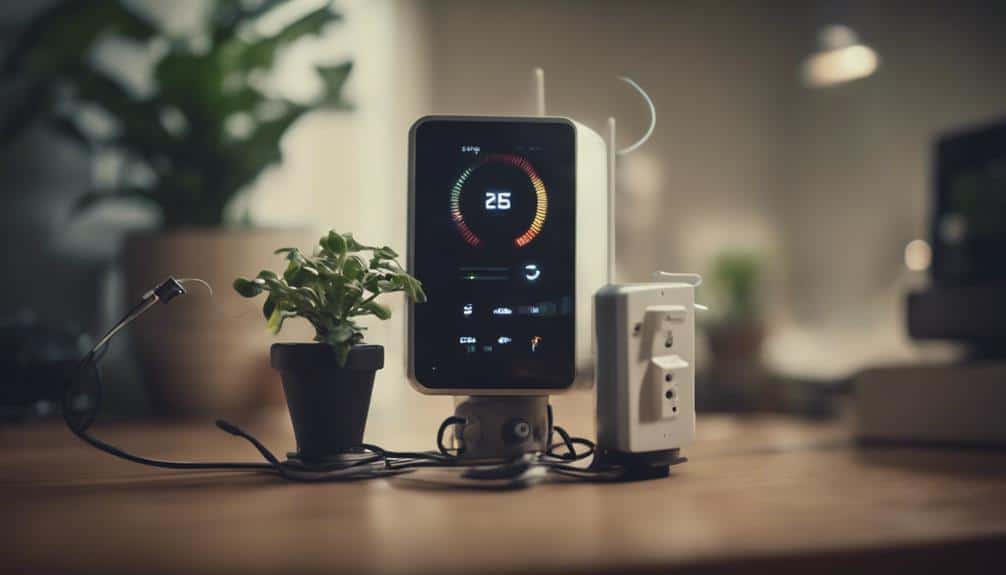Imagine standing in the middle of a digital forest, where every tree is a temperature sensor, and the pathways between them are either paved with Zigbee or Wi-Fi.
You're about to choose a path, but it's not just about the walk; it's about understanding the landscape. Zigbee offers a trail through a self-managing, energy-efficient network, weaving through the woods with enhanced security and an expanding mesh of connections.
Wi-Fi, on the other hand, provides a straightforward path, with easy setup and a robust, reliable signal. Both routes promise to lead you to your destination, but the journey and what you carry matter.
Let's unpack the essentials to help you navigate this decision with confidence, knowing that the right choice could have a significant impact on your smart home or office environment.
Key Takeaways
- Zigbee temperature sensors offer longer battery life due to their low power consumption.
- Wi-Fi temperature sensors provide easier installation by connecting directly to existing networks.
- Zigbee ensures robust data security with advanced encryption, ideal for sensitive environments.
- Wi-Fi sensors may require additional range extenders in larger spaces, affecting setup simplicity.
Understanding Zigbee
Delving into Zigbee, you'll find it's a low-power wireless standard pivotal for smart home technologies. Unlike its counterpart, Wi-Fi, Zigbee shines in scenarios demanding low power consumption and extended network coverage, attributes essential for the seamless operation of smart homes.
Its ability to operate in unlicensed frequency bands such as 2.4GHz enables it to coexist with other wireless technologies, yet it uniquely supports a mesh network topology. This means devices can communicate through each other, not just directly with a central hub, enhancing coverage and reliability.
Particularly beneficial for battery-operated devices like temperature sensors, Zigbee's efficient energy use guarantees long-lasting performance. Plus, its advanced encryption algorithms provide robust security for your smart home's temperature data, making Zigbee a smart choice for your wireless needs.
Exploring Wi-Fi

You're familiar with Wi-Fi's widespread use in gadgets around your home, but let's explore how it fares in temperature sensors.
We'll cover how its connectivity range, power consumption, and network security measures stack up. Understanding these aspects will help you make an informed decision in choosing the right technology for your needs.
Wi-Fi Connectivity Range
When exploring Wi-Fi connectivity range, it's important to highlight that it typically spans over 35 meters indoors, offering a broad coverage area for temperature sensors.
To make sure your entire space is covered, you can use Wi-Fi range extenders. These handy devices boost your signal strength, making certain that every corner of your home or office can connect seamlessly.
However, it's important to remember that adding too many IoT devices, like temperature sensors, to your network can strain your bandwidth. This might affect the overall performance and signal strength.
Also, the placement and configuration of your Wi-Fi range extenders are key. You'll want to set them up in locations that maximize coverage without overloading your network's bandwidth or putting too much pressure on client devices.
Power Consumption Considerations
When it comes to Wi-Fi temperature sensors, they generally have a higher power consumption compared to their Zigbee counterparts. This increased energy consumption can lead to a few notable considerations:
- Shorter battery life: Since Wi-Fi sensors are constantly connected for data transmission, their batteries tend to run out faster.
- Frequent battery replacements or recharging: You'll find yourself needing to change or charge batteries more often, which can be a bit of a hassle.
- The importance of power management strategies: To make the most out of your Wi-Fi sensors, implementing effective power management strategies is essential.
Despite these challenges, understanding and optimizing power consumption can greatly enhance the battery life of Wi-Fi sensors, making them a viable option for your temperature monitoring needs.
Network Security Measures
After considering power consumption, it's also important to look at how Wi-Fi temperature sensors secure your data. Unlike Zigbee, Wi-Fi relies on protocols like WPA3 to safeguard your information during transmission. This means your data's privacy is a priority, with encryption standards that are constantly evolving.
You'll also find that Wi-Fi devices often require fixed IP addresses, adding an extra layer of security measures. But remember, the significance of your network's security isn't critical. Firmware updates play a vital role in keeping your devices secure and functioning at their best.
However, Wi-Fi's dependence on specific vendor ecosystems and cloud servers for device communication can influence your data's security and privacy. So, when weighing Zigbee vs Wi-Fi, consider how each handles network security measures and data protection.
Connectivity Range

You'll often find that the connectivity range dramatically influences your choice between Zigbee and WiFi temperature sensors for your space. Here are three key points to take into account:
- Zigbee sensors excel in larger areas, boasting a range of up to 100 meters in open spaces. This is due to their mesh network topology which extends coverage without sacrificing performance.
- WiFi sensors are more suited for smaller, residential settings, with a typical indoor range of about 35 meters. In larger spaces, you might need additional range extenders.
- The mesh network of Zigbee sensors allows for a seamless expansion of your network, making it a robust choice for sprawling homes or commercial buildings.
Choosing the right connectivity range can ensure peak performance and convenience in your temperature monitoring setup.
Power Consumption

When it comes to keeping your sensors running longer, you'll find Zigbee's lower energy use a real game-changer, especially in spots where changing batteries is a hassle.
On the flip side, WiFi sensors' need for continuous power can make them less ideal for those hard-to-wire locations.
Let's explore how this affects battery life and what it means for your setup.
Zigbee's Lower Energy Use
In comparing Zigbee and WiFi temperature sensors, it's obvious that Zigbee's lower energy consumption offers significant advantages for both battery life and efficiency. Its energy-efficient, low-power design guarantees that you're not constantly changing batteries, especially in spots that are tough to reach. Here's how Zigbee stands out:
- Energy-efficient technology guarantees minimal power use, stretching out battery life considerably.
- Low-power design means your sensors can run for ages without needing a battery swap, making them perfect for remote areas.
- Smart home applications benefit greatly from Zigbee's power efficiency, keeping your home connected without the high energy bill.
Zigbee's approach to power consumption not only saves you time and effort but also aligns with a smart, efficient home environment.
Wifi's Continuous Power Need
WiFi temperature sensors' continuous power demand means they'll often need a direct plug-in, affecting their placement flexibility and overall energy consumption. Unlike their Zigbee counterparts, which thrive on low power consumption, WiFi sensors' thirst for energy impacts not just their battery life but also where you can place them. If you're eyeing energy efficiency and usage scenarios where freedom of placement is key, this is a vital consideration.
| Feature | WiFi Sensors | Zigbee Sensors |
|---|---|---|
| Power Consumption | High | Low |
| Battery Life | Shorter | Longer |
| Placement Flexibility | Limited | High |
| Energy Efficiency | Lower | Higher |
| Ideal Usage Scenario | Near power sources | Flexible |
This table sheds light on why understanding these differences is essential for selecting the right temperature sensor based on your needs.
Battery Life Comparison
Understanding the need for energy efficiency leads us to contemplate how battery life varies greatly between Zigbee and WiFi temperature sensors. Here's what you need to know:
- Zigbee sensors, with their low power consumption design, boast a longer battery life. They're optimized for low data rate transmission, which enhances their energy efficiency, allowing for extended operation without frequent battery changes.
- WiFi sensors, on the other hand, are tailored for higher data transfer rates. This capability, while beneficial, leads to increased power consumption and, consequently, shorter battery life.
- The difference in power consumption directly influences their maintenance requirements; Zigbee sensors demand less frequent attention compared to their WiFi counterparts.
In summary, choosing between Zigbee and WiFi temperature sensors hinges on balancing power consumption, battery life, and maintenance needs.
Data Security

When choosing between Zigbee and WiFi temperature sensors, it's important to consider their data security features, as Zigbee tends to offer more robust protection. Zigbee sensors shine in their ability to create a self-managing network that greatly limits external communication, reducing the risk of data breaches. This mesh network capability not only enhances data security through better network isolation but also lowers energy consumption, making them a go-to for security-conscious setups.
On the other hand, WiFi sensors, while convenient, may rely on vendor cloud servers, introducing potential security vulnerabilities. Additionally, their need for fixed IP addresses for security purposes can inadvertently expose them to external threats if not carefully managed.
Installation Complexity

After exploring data security, let's now examine the installation complexity of Zigbee versus WiFi temperature sensors. You'll find that:
- Zigbee sensors often require an extra step – the purchase and setup of a Zigbee hub. This acts as the main gatekeeper for communication, adding a layer to the setup process. Plus, initiating the pairing process with this hub can be a bit more intricate than you'd anticipate.
- WiFi sensors, on the other hand, are more straightforward. They connect directly to your existing WiFi network, eliminating the need for additional intermediary devices.
- Setting up a Zigbee mesh network for best performance involves further configuration. This network enhances coverage but requires you to understand and configure multiple devices to work together seamlessly.
Compatibility and Ecosystem

Diving into compatibility and ecosystem differences, you'll notice Zigbee and WiFi temperature sensors have unique ways of integrating into your smart home setup. Zigbee sensors effortlessly join the dance with Zigbee hubs, making them a perfect partner for your existing smart devices. They communicate directly with these hubs, sidestepping the need for external servers. This not only boosts data privacy but also keeps things running smoothly, even during internet downtimes.
On the flip side, WiFi sensors play a slightly different tune. They require a solid WiFi network and might need extra steps or specific hubs to gel with your other gadgets. Although they're pretty versatile, they often rely on vendor-specific cloud services for data handling, which could stir up some data privacy concerns. Plus, Zigbee's low-power operation means your sensors can keep going without missing a beat, ensuring you're always in the know.
Future Developments

Looking ahead, the emergence of the Matter protocol is set to revolutionize smart home connectivity by streamlining the use of Zigbee and other technologies. This shift heralds significant future developments for the smart home industry, promising:
- Interoperability between a wider range of devices, eliminating the previous barriers.
- Widespread adoption of smart home technologies, as Matter simplifies the setup process.
- Seamless integration with platforms like Home Assistant, enhancing user experiences.
Despite some skepticism about Matter's progress, its support from major players and solutions like Sky Connect for controlling Zigbee devices underscores its potential.
As routers and devices roll out, we're on the cusp of a more cohesive, interoperable smart home ecosystem, ensuring your temperature sensors work more harmoniously than ever.
Frequently Asked Questions
What Is the Difference Between Zigbee and Wi-Fi?
You're wondering about the differences between Zigbee and Wi-Fi. Zigbee excels in connectivity range, power consumption, and security protocols, with a simpler network topology and installation. Wi-Fi, though, often faces higher power usage and complex setups.
Which Is Better Zigbee Sensor or Wi-Fi Sensor?
You'll find Zigbee sensors excel in energy efficiency and network scalability, while Wi-Fi sensors shine in installation ease, device compatibility, and cost. Your choice depends on what you value most for your smart home setup.
What Are the Benefits of Zigbee Over Wi-Fi?
You'll find Zigbee shines with its mesh networking, offering extended coverage and enhanced signal reliability. Its power efficiency saves energy, while network scalability and strong security features protect your data. Plus, device compatibility is a breeze.
How Accurate Is the Zigbee Temperature Sensor?
You'll find Zigbee temperature sensors' accuracy varies, often around ±0.5°C. Sensor calibration, environmental conditions, and avoiding signal interference boost precision. Remember, accuracy also hinges on battery health and proper placement to mitigate environmental impact.
Conclusion
So, you're weighing Zigbee against Wi-Fi for your temperature sensing needs. Zigbee shines with its efficient, secure mesh network, perfect for expanding setups without draining power.
Wi-Fi, though, is your go-to for straightforward setup and leveraging existing networks. Consider your priorities: is it ease of use, or extensive, energy-efficient coverage?
Either way, both technologies are evolving, promising even smarter, more integrated solutions ahead. Choose what fits best now, and stay tuned for what's coming.

